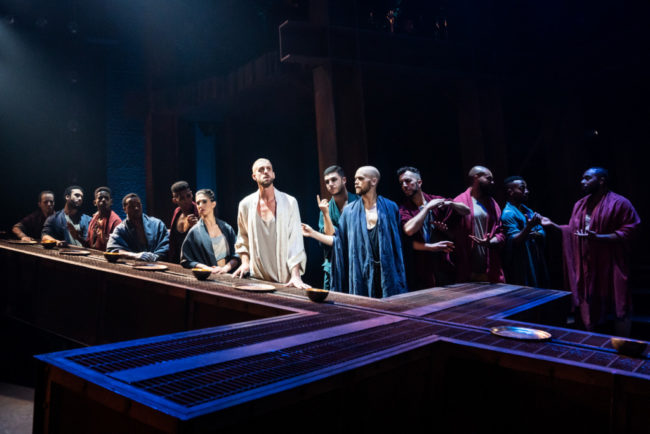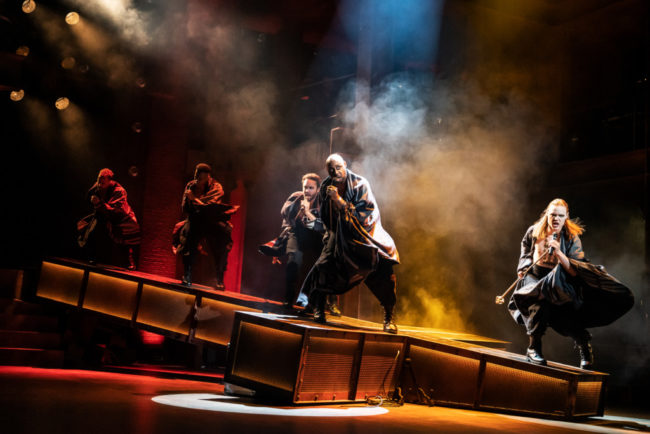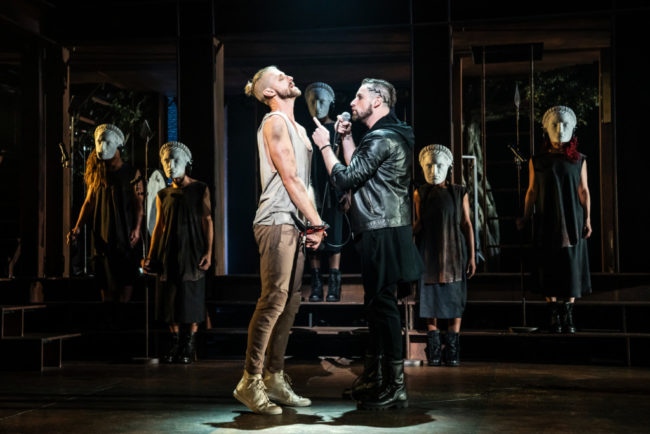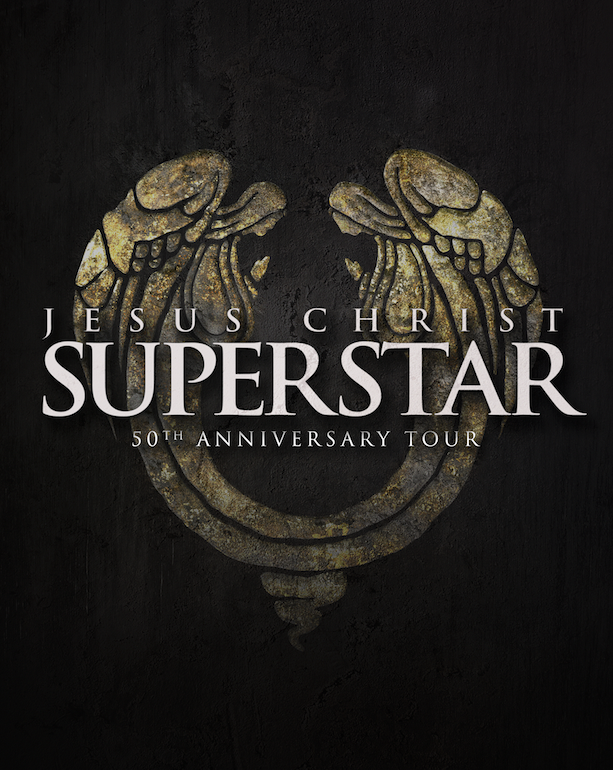Strip away myth from the man and you get a strangely vexing yet utterly intriguing new-age production of Andrew Lloyd Webber’s Jesus Christ Superstar. Now appearing, albeit unseasonably, at The Hippodrome Theatre in the France-Merrick Performing Arts Center, this original rock opera, the first of its kind back in 1970 is now celebrating its 50th Anniversary Tour. Directed by Timothy Sheader with Choreography by Drew McOnie, the production is a post-apocalyptic amalgamation of its rock musical concert roots and modernity that burble caustically in some spots but gel smoothly in others. The production is at odds, and at times, at war with itself, despite having some very impressive features.

Aesthetically, the minimalist set, though subtly populated with crucifixes all throughout the wooden scaffolding— which not only serves as scenery but also the encasement for the orchestra, which can be seen on stage at all times— is well suited for the post-apocalyptic feel that is generated by the grungy wardrobe and sinister opening chords of the overture, all of which assault the senses quite early on to draw the audience into this unstable and almost volatile concept of Jesus Christ Superstar. Scenic and Costume Designer Tom Scutt adds rocker grunge where appropriate— making Pilate look like he strolled in from a production of American Idiot, while Herod’s outlandishly decadent costume reads more along the lines of a production of Folles. The intentionally inverted crucifix, which is a multi-purpose staging unit used throughout the performance as a raked-tilt entrance, the last supper table, and ultimately the mound of Jesus’ crucifixion, sends a message, which stirs up some of the original controversy of the production’s rebellious origins.
Conceptually the show is bundled up— quite literally— in the notion of being a rock concert. The soloists and principal characters all sing into hand-held mics or mics on stands. At times this is shockingly effective. When Caiaphas, Annas, and the Priest Trio present their various sinister numbers, not only do they sway and lean on their microphone stands, but the stands double up as their spears and staffs of piety and self-righteousness. At other times, like when Mary is singing “Everything’s Alright”, it pulls the focus of what’s happening. Half her song is delivered in true concert style, with the performer facing the audience and delivering the number to them, while the other half gets spun and pitched at Jesus, with seemingly little balance or reasoning for the shift in perspective. It is this moment, and others like it, which create one of the many wars within the production; either embrace the concept of a concert or play with the illusion of one (by the exquisite use of XLR cables, mic stands, and microphones), but don’t crisscross needlessly between the two.
As mentioned, Director Timothy Sheader has incorporated a symbolic use of concert gear into the performance. Judas’ mic and long XLR cable are symbolically used to represent the character’s end, Jesus is bound for his flogging in Pilate’s palace with XLR cables, his crucifix is assembled from a PA stand and mic stand. All of these elements really ingratiate the concert notion into the production’s core. There are other concepts, however, in Sheader’s production that fight with one another. The way Sheader choses to execute the iconic flogging of Jesus is visually impactful but an oddly disagreeable sentiment; fistfuls of gold glitter are whammed against Jesus from various members of the ensemble (all dressed in their pending titular number gospel choir robes) while Caiaphas looms overhead, slapping a wooden clapboard to create the sound of the whip. It’s hard to describe what exactly about this choice doesn’t work, it’s just odd and unsettling.

There are praises to be lauded upon the newly rendered version of this Jesus Christ Superstar, not the least of which is the stellar light work of Lighting Designer Lee Curran; 90 minutes with no intermission and no noticeable cuts of any of the musical numbers (diehard enthusiast fans not withstanding) is an impressive feat. But because of this truncated intensity, there are times where the production feels rushed. This is particularly true with the choreographer. Drew McOnie’s choreography is a myriad of confusing concepts. “Jesus Christ Superstar” and “Simon of Zealotes” look and feel like a music video for “Sweating to the Oldies: Broadway Edition” circa 1970. The choreography is extremely athletic and aerobic. At other times the choreography is robotic but simultaneously spastic, like Autons going berserk. This is seen most readily during the opening number and again during the temple. Overall the choreography’s cleanliness is inconsistent; much of the rushed-tempo and pacing of the show seems to lead to sloppy execution and frenzied motions.
Vocally the show is impressive, though the principles struggle with their upper range and screaming top tenor. This is particularly disappointing as this is one of the iconic features of Jesus Christ Superstar. There are also moments where the performances of various numbers feel disconnected from their emotional structures. This is particularly true of Judas’ “Damned For All Time” and Jesus’ “Gethsemane.” This seems to be attributed to the odd approach of concert versus stage show in this production, and because the focus of where the song is being directed is haphazardly split, the emotional gravity of these numbers falls short. Judas (James Delisco Beeks) and Jesus (Aaron LaVigne) lack the volatile chemistry that often accompanies this pairing in this musical show, but again that feels more the fault of the truncation of the production rather than the performers. Mary (Jenna Rubaii) has a strange interplay with both Jesus and Judas, where her sultry semi-seductive side is shown toward Jesus but the discord and tension between her and Judas is severely lacking. Ultimately the three lead performers do have strong vocals, even if there are extreme moments of disconnect and vocal strain.

Standouts in the production include the gritty Pilate (Tommy Sherlock) who brings an astonishing presence to “Trial By Pilate/39 Lashes.” Sherlock, who is fully present in this scene with Jesus and those screaming to crucify Jesus, despite holding a microphone in his hand, delivers a rousing and evocative rendition of this number, really bringing a compassionate, albeit fury-driven, heart forward in the song. Simon (Eric A. Lewis) who receives the self-titled feature solo puts soulful spirit into this song and really amps up the energy of the number.
Caiaphas (Alvin Crawford) and Annas (Tyce Green), accompanied by the Three Priests (Brian Golub, Garfield Hammonds, Charles McCall,) are one of the most impressive features in this production. Crawford’s mesmerizing and haunting bass tone is stunning and will thrill you, even though he is arguably the catalyst for the downfall of Jesus. When paired together, Crawford and Green create those eerie sounds, the attic of the screaming tenor range juxtaposed against the cellar bass range, which pleasantly unsettle the soundscape of the show. Their blocking and overall staging on the raked cross fixture is exquisite in addition to the sounds their create.
Ultimately a menagerie of differing experiences, the 50th anniversary tour of Jesus Christ Superstar has some impressive features, is well parsed in 90 minutes or less despite some of its choreographic chaos, and is a great way to introduce new potential fans and more traditional lovers to the show.
Running Time: Approximately 90 minutes with no intermission
Jesus Christ Superstar plays through December 22, 2019 Baltimore’s Hippodrome Theatre in the France-Merrick Performing Arts Center— 12 N. Eutaw Street in the Bromo Seltzer Arts District of Baltimore, MD. For tickets call the box office at (410) 752-7444 or purchase them purchase them online.

